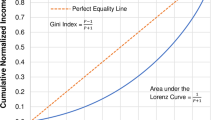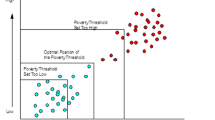Abstract
We study to what extent some functional form assumption on the Lorenz curve are amenable to calculating headcount poverty, or poverty threshold, the key concept to determine a poverty index. The difficulties in calculating it have been underestimated. We must choose some functional forms for the Lorenz concentration curve. We examine three families of one-parameter functional forms to estimate Lorenz curves: power (elementary and Pareto), exponential (elementary and Gupta) and fractional (Rohde). Computing these numerical functions may be difficult and impose some restrictions on their domain of definition, may impose to use some numerical approximation methods. The elementary power and exponential forms are not a problem. However, Pareto raises the problem of a restricted domain of definition for its parameters. The exponential form of Gupta leads to a Lambert function that poses multiple problems, including a restricted field of definition. The fractional form of Rohde has also a restricted domain of definition. It is probably time to choose functional forms not only according to their ability to fit the data, but also according to their ability to calculate poverty indices.
Similar content being viewed by others
Data Availability Statement
My work proceeds within a theoretical and mathematical approach, so I do not analyze or generate any datasets.
References
Abramovitz, M., Stegun, I. (eds.): Handbook of mathematical functions with formulas, graphs, and mathematical tables. National bureau of standards, applied mathematics series, 55, New York: Dover Tenth Printing (December 1972) with corrections (1964)
Arnold, B.C.: Pareto and generalized Pareto distributions. In: Chotikapanich, D.E. (ed.) Modeling income distribuions and lorenz curves, vol. 5 of economic studies in equality, social exclusion and well-being. Springer, New-York, chap. 7. pp 119–145 (2008)
Atkinson, A.: The measurement of inequality. J. Econ. Theory 2, 244–263 (1970)
Bourguignon, F., Chakravarty, S.R.: The measurement of multidimensional poverty. J. Econ. Inequal. 1, 25–49 (2003)
Cheong, K.S.: An empirical comparison of alternative functional forms for the Lorenz curve. Appl. Econ. Lett. 9, 171–176 (2002)
Chotikapanich, D.: A comparison of alternative functional forms for the Lorenz curve. Econ. Lett. 41(2), 129–138 (1993)
Corless, R.M., Gonnet, G.H., Hare, D.E.G., Jeffrey, D.J.: Lambert’s w function in maple. The Maple Technical Newsletter (MapleTech) 9, 12–22 (1993)
Corless, R.M., Gonnet, G.H., Hare, D.E.G., Jeffrey, D.J., Knuth, D.E.: On the lambert w function. Adv. Comput. Math. 329–359 (1996)
Coudouel, A., Hentschel, J.S., Wodon, Q.T.: Poverty Measurement and Analysis. In: Klugman, J (ed.) A Source Book for Poverty Reduction Strategies, Introduction to Poverty Analysis, pp 26–29. International Bank for Reconstruction and Development / The World Bank, Washington D.C. (2002)
Donaldson, D., Weymark, J.: A single-parameter generalization of the Gini indices of inequality. J. Econ. Theory 22(1), 67–86 (1980)
Fellman, J.: Estimation of Gini coefficients using Lorenz curves. J. Stat. Econ. Methods 1(2), 31–38 (2012)
Fellman, J.: Modelling Lorenz curves. J. Stat. Econ. Methods 1(3), 53–62 (2012)
Foster, J., Greer, J., Thorbecke, E.: A class of decomposable poverty measures. Econometrica 52, 761–766 (1984)
Gastwirth, J.L.: A general definition of the Lorenz curve. Econometrica 39(6), 1037–1039 (1971)
Gastwirth, J.L.: The estimation of the lorenz curve and gini index. Rev. Econ. Stat. 54(3), 306–316 (1972)
Golden, J.: A simple geometric approach to approximating the Gini coefficient. J Econ Educ 39(1), 68–77 (2008)
Gupta, M.R.: Functional form for estimating the Lorenz curve. Econometrica 52, 1313–1314 (1984)
Hossain, S., Saeki, C.: A new functional form for estimating lorenz curves. J. Business Econ Res. 1, 43–58 (2003)
Kakwani, N.C.: Applications of Lorenz curves in economic analysis. Econometrica 45(3), 719–727 (1977)
Kakwani, N.C.: On a class of poverty measures. Econometrica 4, 437–446 (1980)
Kakwani, N.C., Podder, N.: On the estimation of lorenz curves from grouped observations. Int. Econ. Rev. 14, 278–292 (1973)
Kakwani, N.C., Podder, N.: Efficient estimation of the lorenz curve and the associated inequality measures from grouped observations. Econometrica 44, 137–148 (1976)
Lambert, J.H.: Observationes variae in mathesin puram. Acta Helveticae physico-mathematico-anatomico-botanico-medica III, 128–168 (1758)
Lorenz, M.O.: Methods of measuring the concentration of wealth. Publ. Am. Stat. Assoc. 9(70), 209–219 (1905)
Lubrano, M.: Lorenz curves, the Gini coefficient and parametric distributions. In: The Econometrics of Inequality and poverty, Chap. 4. Available at www.vcharite.univ-mrs.fr/PP/lubrano/cours/lecture-4.pdf (2017). Accessed 10 Oct 2016
Mckay, A.: Defining and measuring inequality. In: Inequality Briefing, Produced for the UK Department for International Development (DFID) by the Economists’ Resource Centre (ERC), Briefing Paper No 1 (1 of 3) (2002)
Moyes, P.: Stochastic dominance and the lorenz curve. In: Silber, J. (ed.) Handbook of Income Inequality Measurement, Springer (1999)
Ogwang, T., Rao, U.L.G.: Hybrid models of the Lorenz curve. Econ. Lett. 69, 39–44 (2000)
Ortega, P., Martin, G., Fernandez, A., Ladoux, M., Garcia, A.: A new functional form for estimating lorenz curves. Rev. Income Wealth 37, 4 (1991)
Prieto-Alaiz, M.: Spanish Economic Inequality and Gender: A Parametric Lorenz Dominance Approach. In: Bishop, J. A., Amiel, Y. (eds.) Inequality and Poverty, Papers from the Society for the Study of Economic Inequality’s Inaugural Meeting Research on Economic Inequality, vol. 14. Elsevier, Amsterdam (2007)
Rao, U.L.G., Tam, A.Y.-P.: An empirical study of selection and estimation of alternative models of the Lorenz curve. J. Appl. Stat. 14, 275–280 (1987)
Rasche, R.H., Gaffney, J., Koo, A.Y.C., Obst, N.: Functional forms for estimating the lorenz curve. Econometrica 48, 1061–1062 (1980)
Reed, W.J.: The Pareto law of incomes: an explanation and an extension. Phys. A 319, 469–486 (2003)
Rohde, N.: An alternative functional form for estimating the Lorenz curve. Econ. Lett. 105,1, 61–63 (2009)
Rossi, J.W.: Notes on a new functional form for the Lorenz curve. Econ. Lett. 17(1-2), 193–197 (1985)
Sarabia, J.M.: Parametric Lorenz Curves: Models and Applications. In: Chotikapanich, D.E. (ed.) Modeling Income Distribuions and Lorenz Curves, vol. 5 of Economic Studies in Equality, Social Exclusion and Well-Being. Springer: New-York, Chap. 9, pp. 167–190 (2008)
Sarabia, J.M., Castillo, E., Slottje, D.J.: An ordered family of Lorenz curves. J. Econ. 91, 43–60 (1999)
Sen, A.: Poverty: an ordinal approach to measurement. Econometrica 44, 219–231 (1976)
Shorrocks, A.F.: Ranking income distributions. Economica 50(197), 3–17 (1983)
Thistle, P.D., Formby, J.P.: On one parameter functional forms for lorenz curves. Eastern Econ J 14,1, 81–85 (1988)
Wilfling, B., Kramer, W.: The Lorenz-ordering of Singh-Maddala income distributions. Econ. Lett. 43(1), 53–57 (1993)
Xu, K.: How has the literature on Gini’s index evolved in the past 80 years? Economics working paper Dalhousie University Available at SSRN: http://ssrn.com/abstract=423200 or https://doi.org/10.2139/ssrn.423200 (2003). Accessed 2 June 2022
Yitzhaki, S.: More than a dozen alternative ways of spelling Gini. Res. Econ. Ineq. 8, 13–30 (1998)
Yitzhaki, S., Schechtman, E.: More than a Dozen Alternative Ways of Spelling Gini. In: Yitzhaki, S., Schechtman, E (eds.) The Gini Methodology. Springer Series in Statistics, Vol 272. Springer, New York, NY, pp. 11–31 (2013)
Zheng, B.: Testing Lorenz curves with non-simple random samples. Econometrica 70, 1235–1243 (2002)
Author information
Authors and Affiliations
Corresponding author
Ethics declarations
Conflict of Interests
The author has no relevant financial or non-financial interests to disclose.
Additional information
Publisher’s note
Springer Nature remains neutral with regard to jurisdictional claims in published maps and institutional affiliations.
Supplementary Information
ESM 1
(PDF 951 KB)
Rights and permissions
About this article
Cite this article
de Mesnard, L. About some difficulties with the functional forms of Lorenz curves. J Econ Inequal 20, 939–950 (2022). https://doi.org/10.1007/s10888-022-09542-w
Received:
Accepted:
Published:
Issue Date:
DOI: https://doi.org/10.1007/s10888-022-09542-w




